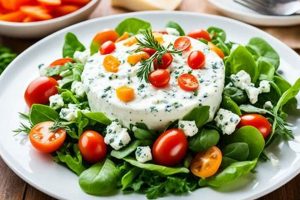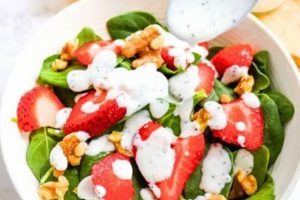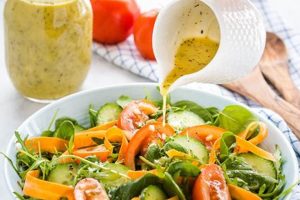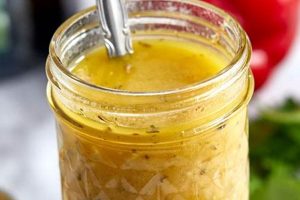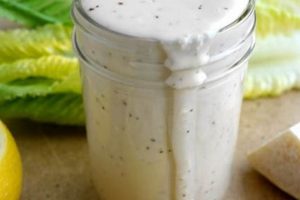Creamy, flavorful dressings based on yogurt offer a versatile and healthful alternative to traditional mayonnaise or vinaigrette-based options. These dressings typically incorporate yogurt, often Greek yogurt due to its thicker consistency, alongside ingredients like herbs, spices, citrus juices, and sometimes a touch of oil or honey for added richness and sweetness. A simple example combines plain yogurt with lemon juice, minced garlic, dill, salt, and pepper.
Yogurt-based dressings provide several advantages. Their lower fat and calorie content compared to mayonnaise-based counterparts makes them a healthier choice. Yogurt also contributes probiotics, beneficial bacteria that support gut health. Furthermore, the tangy flavor profile of yogurt complements a wide array of salad ingredients, from leafy greens and vegetables to grains and proteins. Historically, yogurt has been a staple in various cuisines for centuries, and its incorporation into dressings represents a modern adaptation of a traditional ingredient.
This exploration will further delve into the creation of these dressings, covering specific recipes, variations, suitable pairings, and storage recommendations. It will also address common questions related to ingredient substitutions and techniques for achieving desired textures and flavors.
Tips for Creating Exceptional Yogurt-Based Dressings
Achieving optimal flavor and texture in yogurt-based dressings requires attention to detail and an understanding of ingredient interactions. The following tips provide guidance for crafting dressings that elevate any salad.
Tip 1: Start with Thick Yogurt: Greek yogurt is generally preferred for its thicker consistency, which creates a more substantial dressing. Straining regular yogurt through cheesecloth can also achieve a similar texture.
Tip 2: Balance Tanginess with Sweetness: The natural tang of yogurt can be balanced with a touch of sweetness using honey, maple syrup, or a pinch of sugar. Taste and adjust accordingly.
Tip 3: Incorporate Fresh Herbs and Spices: Fresh herbs like dill, mint, parsley, or chives add brightness and complexity. Spices such as cumin, coriander, or paprika can create unique flavor profiles.
Tip 4: Emulsify with a Small Amount of Oil: A tablespoon or two of olive oil, or another preferred oil, can help create a smoother, more emulsified dressing. Whisk vigorously to combine.
Tip 5: Adjust Consistency with Liquid: If the dressing is too thick, thin it with a small amount of water, milk, or additional lemon juice or vinegar.
Tip 6: Season Carefully: Salt and freshly ground black pepper are essential for enhancing the overall flavor. Start with a small amount and adjust to taste.
Tip 7: Allow Flavors to Meld: Refrigerating the dressing for at least 30 minutes before serving allows the flavors to blend and deepen.
By following these guidelines, one can consistently produce flavorful, healthy, and versatile dressings that complement a wide range of salads and ingredients.
These tips provide a foundation for crafting exceptional yogurt-based dressings, but experimentation is encouraged. The next section will explore specific recipe examples and variations.
1. Yogurt Selection (Greek, plain)
Yogurt selection significantly influences the final character of a yogurt-based salad dressing. The choice between Greek yogurt and plain yogurt impacts texture, flavor profile, and overall nutritional value. Understanding the distinctions between these options allows for informed decision-making when crafting the ideal dressing.
- Texture and Consistency
Greek yogurt, strained to remove whey, possesses a thicker, creamier consistency than plain yogurt. This characteristic contributes to a richer, more substantial dressing that clings well to salad ingredients. Plain yogurt, retaining its whey content, offers a thinner, lighter texture, resulting in a dressing that coats ingredients more delicately. The desired texture often dictates the choice between these two options.
- Tanginess and Flavor Profile
Greek yogurt, due to its concentrated nature, exhibits a more pronounced tang compared to plain yogurt. This tanginess can provide a vibrant counterpoint to other ingredients in the dressing. Plain yogurt, milder in flavor, offers a more neutral backdrop, allowing other flavors to shine through. The overall flavor balance of the dressing is affected by this inherent yogurt tang.
- Nutritional Content
Straining alters the nutritional composition of yogurt. Greek yogurt typically boasts higher protein and lower carbohydrate content compared to plain yogurt. Conversely, plain yogurt tends to be higher in calcium and lower in calories. Consideration of dietary goals and nutritional requirements can guide yogurt selection.
- Versatility and Adaptability
Both Greek and plain yogurt offer versatility in dressing preparation. Greek yogurt’s thickness lends itself well to dressings intended for heartier salads or as dips. Plain yogurt’s lighter texture suits dressings for more delicate greens or as marinades. The adaptability of each type expands creative possibilities.
Ultimately, the choice between Greek yogurt and plain yogurt depends on the desired characteristics of the final dressing. Whether prioritizing a creamy texture, a pronounced tang, specific nutritional values, or adaptability to various applications, careful yogurt selection sets the stage for a successful and flavorful dressing.
2. Flavor Balancing (sweet, tangy)
Flavor balancing, specifically the interplay between sweet and tangy elements, forms a cornerstone of successful yogurt-based salad dressings. Yogurt’s inherent tanginess, derived from lactic acid produced during fermentation, necessitates careful consideration of complementary flavors. This balance prevents the dressing from becoming overly tart and ensures a harmonious flavor profile that enhances the overall salad experience. A dressing overly reliant on yogurt’s tang can overwhelm delicate greens or clash with other ingredients. Conversely, insufficient tanginess can result in a bland, uninspiring dressing. The goal is to achieve a balanced profile where the tangy notes of the yogurt are complemented and rounded out by sweeter elements.
This balance can be achieved through various ingredients. Honey, maple syrup, or agave nectar offer natural sweetness that harmonizes with yogurt’s tang. A small amount of granulated sugar or a pinch of stevia can also be used, though natural sweeteners often contribute a more complex flavor profile. The specific sweetener chosen influences the final flavor; for instance, honey imparts a floral sweetness, while maple syrup offers a subtle caramel note. Quantities must be carefully adjusted; a general guideline is to start with a small amount of sweetener and gradually increase until the desired balance is reached. Taste testing throughout the process is crucial for achieving the perfect equilibrium. For example, a dressing featuring Greek yogurt, lemon juice, and dill might benefit from a teaspoon of honey to temper the combined tanginess of the yogurt and lemon. Conversely, a dressing based on plain yogurt with milder flavors may require less sweetener.
Mastering this interplay of sweet and tangy flavors is essential for creating a well-rounded and enjoyable yogurt-based salad dressing. The delicate balance elevates the dressing beyond a simple condiment, transforming it into an integral component of the salad itself. Failure to achieve this balance can detract from the overall dining experience, highlighting the practical significance of understanding flavor dynamics. Through careful ingredient selection and meticulous adjustment, a harmonious flavor profile can be achieved, resulting in a dressing that complements and enhances the salad’s other components.
3. Ingredient Incorporation (herbs, spices)
Ingredient incorporation, specifically the strategic use of herbs and spices, significantly elevates yogurt-based salad dressings beyond simple condiments. Fresh herbs and spices contribute layers of complexity, enhancing the overall flavor profile and creating dressings that complement a wide range of salad ingredients. Careful selection and balanced application of these ingredients transform yogurt into a versatile culinary canvas.
- Fresh Herbs: Enhancing Brightness and Aroma
Fresh herbs impart vibrant flavors and aromatic notes to yogurt dressings. Dill, mint, parsley, chives, and cilantro are popular choices, each offering a unique character. Dill’s delicate anise flavor pairs well with cucumbers and feta, while mint adds a refreshing touch to Mediterranean-inspired salads. Parsley provides a clean, slightly peppery taste, while chives offer a subtle oniony nuance. Cilantro contributes a bright, citrusy flavor often used in Southwestern or Asian-inspired dressings. Selecting herbs that complement the other salad ingredients is essential for a harmonious flavor profile.
- Dried Spices: Adding Depth and Warmth
Dried spices contribute warmth and depth to yogurt dressings. Cumin, coriander, paprika, and garlic powder are common additions. Cumin offers an earthy, slightly smoky flavor, while coriander provides a citrusy, warm note. Paprika adds a touch of sweetness and subtle heat, while garlic powder delivers a pungent savory flavor. Dried spices are particularly effective in dressings intended for roasted vegetables or grain-based salads. The concentrated nature of dried spices requires judicious use to prevent overpowering the other flavors.
- Balancing Flavors: Achieving Harmony and Complexity
Balancing the flavors of herbs and spices is crucial. Overusing a single ingredient can create a monotonous flavor profile. Combining complementary herbs and spices, such as dill and lemon zest or cumin and coriander, creates a more nuanced and interesting dressing. The intensity of flavors should also be considered; delicate herbs like dill may be overpowered by stronger spices like cumin. Careful balancing ensures that each ingredient contributes to the overall complexity without dominating the flavor profile.
- Preparation Techniques: Optimizing Flavor Release
Proper preparation techniques maximize the flavor contribution of herbs and spices. Fresh herbs should be finely chopped to release their aromatic oils and ensure even distribution throughout the dressing. Dried spices can be toasted briefly in a dry pan to enhance their flavor before being added to the yogurt base. Allowing the dressing to rest for at least 30 minutes after preparation allows the flavors to meld and deepen, creating a more cohesive and complex flavor profile.
The thoughtful incorporation of herbs and spices transforms yogurt-based salad dressings into dynamic flavor vehicles. By understanding the unique characteristics of individual ingredients and employing balanced preparation techniques, one can create dressings that not only complement but elevate the overall salad experience. This attention to detail highlights the culinary potential of seemingly simple ingredients and demonstrates the significant impact of ingredient incorporation on the final dish.
4. Texture Enhancement (oil, water)
Texture enhancement plays a crucial role in the overall appeal of yogurt-based salad dressings. Manipulating the texture, primarily through the incorporation of oil and water, allows for customization to suit specific preferences and salad types. Understanding the impact of these additions provides control over the final consistency, from a light and pourable dressing to a thick and creamy dip.
- Oil Incorporation: Emulsification and Richness
Oil contributes to both texture and flavor. A small amount of oil, typically olive oil, avocado oil, or grapeseed oil, creates a smoother, more emulsified dressing. The oil helps to bind the other ingredients and prevents separation, resulting in a more cohesive texture. Additionally, oil adds richness and mouthfeel, enhancing the sensory experience of the dressing. The type of oil chosen can also subtly influence the flavor profile of the dressing.
- Water Addition: Thinning and Consistency Adjustment
Water serves as a simple and effective tool for adjusting the consistency of yogurt-based dressings. If the yogurt base is too thick, adding water gradually, a teaspoon at a time, helps to thin the dressing to the desired consistency. This is particularly useful when creating dressings for delicate greens where a lighter coating is preferred. Over-thinning can be easily rectified with the addition of more yogurt, ensuring adaptability and control over the final product.
- Balancing Oil and Water: Achieving the Desired Texture
Balancing the addition of oil and water is key to achieving the ideal texture. Too much oil can result in a greasy dressing, while too much water can make it thin and watery. The balance depends on the desired consistency and the type of yogurt used. Greek yogurt, being thicker, typically requires more water or less oil than plain yogurt. Careful adjustment and continuous assessment of the texture are essential for achieving the perfect balance.
- Impact on Flavor and Mouthfeel
While primarily used for texture enhancement, both oil and water can subtly influence the flavor and mouthfeel of the dressing. Oil contributes richness and can carry the flavors of infused oils, such as garlic-infused olive oil. Water, while generally flavorless, can slightly dilute the intensity of other ingredients, necessitating minor flavor adjustments. Understanding these subtle influences allows for precise control over the overall sensory experience of the dressing.
Texture enhancement is a crucial step in crafting exceptional yogurt-based salad dressings. The judicious use of oil and water, coupled with careful attention to balance and consistency, allows for the creation of dressings that not only complement the flavors of the salad but also enhance the overall dining experience through textural appeal. This control over texture elevates the dressing from a simple condiment to a crucial component of the dish, demonstrating the importance of understanding the interplay of ingredients and their impact on the final product.
5. Seasoning Adjustment (salt, pepper)
Seasoning adjustment, primarily with salt and pepper, represents a critical final step in developing a balanced and flavorful yogurt-based salad dressing. Salt enhances the inherent flavors of the other ingredients, while pepper adds a subtle layer of complexity and depth. Appropriate seasoning elevates the overall sensory experience, transforming a bland dressing into a vibrant complement to the salad. Inadequate seasoning results in a flat, uninspiring flavor profile, whereas excessive seasoning can overpower the other ingredients and render the dressing unpalatable. This underscores the importance of careful and incremental seasoning adjustments.
Salt’s impact extends beyond mere flavor enhancement. It also plays a functional role in balancing the tanginess of yogurt and the acidity of any added citrus or vinegar. Consider a dressing combining Greek yogurt, lemon juice, and herbs. Salt tempers the combined tanginess of the yogurt and lemon, creating a more harmonious flavor profile. The type of salt used can also influence the final taste. Kosher salt, due to its larger crystal size, offers a gentler salinity than table salt, allowing for more precise control during seasoning. Freshly ground black pepper adds a subtle bite and depth, complementing the other flavors without overpowering them. Pre-ground pepper can often taste stale and lack the vibrancy of freshly ground peppercorns. The quantity of pepper used should be adjusted based on personal preference and the overall flavor profile of the dressing.
Achieving optimal seasoning requires a methodical approach. Start with a small amount of salt and pepper, taste, and adjust incrementally until the desired flavor balance is achieved. It is easier to add more seasoning than to remove it. Furthermore, the flavors of the dressing will meld and intensify over time, so it’s advisable to under-season initially and adjust again after the dressing has rested for at least 30 minutes. This iterative process, coupled with an understanding of the interplay between salt, pepper, and the other ingredients, allows for precise control over the final flavor profile, ensuring a dressing that complements and enhances the overall salad experience rather than detracting from it.
6. Flavor Melding (resting time)
Flavor melding, achieved through a designated resting period, represents a crucial but often overlooked step in creating exceptional yogurt-based salad dressings. Allowing the dressing to rest, typically for 30 minutes to an hour, enables the individual flavors of the various componentsyogurt, herbs, spices, acids, and sweetenersto harmonize and integrate fully. This integration results in a more cohesive and complex flavor profile, transforming a simple mixture into a nuanced culinary creation.
- Ingredient Interaction and Flavor Development
Resting time facilitates interaction between the diverse ingredients within the yogurt-based dressing. Initially disparate flavors begin to meld, creating new flavor dimensions and a more balanced overall profile. The sharp tang of yogurt softens as it interacts with the sweetness of honey or maple syrup. The aromatic oils of fresh herbs diffuse throughout the dressing, imbuing it with their characteristic notes. Spices release their complex flavors, adding depth and warmth. This dynamic interaction elevates the dressing beyond a simple sum of its parts, creating a synergistic flavor experience.
- Texture Stabilization and Emulsification Enhancement
The resting period also contributes to textural stability, particularly in dressings containing oil. Emulsification, the process of dispersing oil droplets within the yogurt base, improves over time, creating a smoother, more cohesive texture. This prevents separation and ensures a consistent mouthfeel. The resting period allows the emulsifying agents, often present in yogurt itself, to fully interact with the oil, creating a stable and homogenous mixture.
- Flavor Intensification and Complexity
Resting allows the flavors of the individual ingredients to intensify and become more pronounced. Similar to marinating, the resting period enables the flavors to penetrate the yogurt base more thoroughly, resulting in a richer, more complex flavor profile. This intensification enhances the overall sensory experience of the dressing, transforming it from a simple condiment into a key element of the dish.
- Practical Implications for Preparation and Serving
Understanding the importance of flavor melding influences practical aspects of salad dressing preparation and serving. Preparing the dressing in advance allows for adequate resting time, ensuring optimal flavor development and texture stabilization. This advance preparation simplifies meal preparation and allows for more efficient time management. It also ensures that the dressing is served at its peak flavor, enhancing the overall dining experience.
Flavor melding, facilitated by a dedicated resting period, represents a fundamental step in maximizing the flavor potential of yogurt-based salad dressings. This seemingly simple act of patience unlocks a cascade of chemical and physical transformations that elevate the dressing from a mere mixture to a carefully crafted culinary creation. The resulting enhancement in flavor, texture, and overall sensory experience underscores the significance of flavor melding in the creation of exceptional yogurt-based dressings. This, in turn, elevates the entire salad, demonstrating the profound impact of allowing flavors to harmonize over time.
7. Dietary Considerations (vegan options)
Dietary considerations, particularly veganism, present specific challenges and opportunities when creating yogurt-based salad dressings. Traditional yogurt, a dairy product, is not suitable for vegan diets. However, the versatility of salad dressings allows for adaptations and substitutions that cater to vegan preferences without sacrificing flavor or texture. Exploring these options expands the accessibility of yogurt-based dressings and demonstrates the adaptability of culinary practices to diverse dietary needs.
- Vegan Yogurt Alternatives
Several plant-based yogurt alternatives provide a suitable base for vegan dressings. These alternatives, typically made from nuts (cashews, almonds), seeds (sunflower, hemp), or coconut, offer a creamy texture and a neutral flavor profile that allows for customization with herbs, spices, and other flavoring agents. The nutritional profile of these alternatives varies; some are fortified with calcium and vitamin B12, important nutrients often lacking in vegan diets. Selecting an alternative based on flavor preference and nutritional needs ensures a suitable foundation for the dressing.
- Flavor Adjustments for Plant-Based Yogurts
Plant-based yogurts often possess distinct flavor profiles that differ from traditional dairy yogurt. Coconut yogurt, for instance, carries a subtle coconut flavor, while cashew yogurt can have a slightly nutty taste. These inherent flavors necessitate adjustments in the other dressing ingredients. A dressing designed for dairy yogurt might require modification when using a plant-based alternative to achieve a balanced flavor profile. For example, a dressing featuring lemon and dill might pair well with cashew yogurt but clash with coconut yogurt. Careful consideration of flavor compatibility is essential.
- Texture Considerations and Adjustments
The texture of plant-based yogurts can also vary significantly. Some, like cashew yogurt, are naturally thick and creamy, while others might be thinner. Texture adjustments, similar to those used for dairy-based dressings, can be employed. Thickening agents, such as arrowroot powder or tapioca starch, can be used to create a more substantial dressing. Conversely, thinning the dressing with water or plant-based milk allows for greater versatility and adaptability to different salad types. Understanding the texture of the chosen plant-based yogurt allows for informed adjustments.
- Nutritional Considerations and Ingredient Selection
Creating nutritionally balanced vegan dressings requires careful ingredient selection. While plant-based yogurts can provide a good source of healthy fats and some micronutrients, incorporating other nutrient-rich ingredients further enhances the nutritional value. Nutritional yeast, for instance, contributes B vitamins and a cheesy flavor. Adding ground flaxseeds or chia seeds boosts omega-3 fatty acid content. Incorporating nutrient-dense ingredients elevates the dressing beyond a simple condiment, transforming it into a valuable component of a balanced vegan meal.
Adapting yogurt-based salad dressings to align with vegan dietary principles highlights the versatility and adaptability of culinary practices. Through careful selection of plant-based yogurt alternatives, thoughtful flavor adjustments, texture modifications, and attention to nutritional content, one can create vegan dressings that rival their dairy-based counterparts in both flavor and nutritional value. This adaptability expands culinary possibilities for individuals following vegan diets and underscores the inclusive nature of culinary creativity.
Frequently Asked Questions
This section addresses common inquiries regarding the preparation and utilization of yogurt-based salad dressings.
Question 1: How long can yogurt-based dressing be stored?
Properly stored in an airtight container in the refrigerator, yogurt-based dressings typically last for up to five days. Discard any dressing that exhibits signs of spoilage, such as mold growth or an off odor.
Question 2: Can dairy yogurt be substituted with non-dairy alternatives?
Dairy yogurt can be replaced with various non-dairy alternatives, such as almond, cashew, soy, or coconut yogurt. Flavor profiles and textures may vary, requiring adjustments to other ingredients.
Question 3: What can be done if the dressing is too thin?
Thickness can be adjusted by adding a small amount of additional Greek yogurt or a thickening agent like arrowroot powder or tapioca starch. Incorporate these additions gradually, assessing consistency until the desired texture is achieved.
Question 4: How can one reduce the tanginess of a yogurt-based dressing?
A touch of sweetness can balance excessive tanginess. Incorporate a small amount of honey, maple syrup, or a pinch of sugar, tasting and adjusting until the desired balance is achieved.
Question 5: What are suitable pairings for yogurt-based dressings?
These dressings complement a wide array of salads, including leafy greens, grain-based salads, and those featuring roasted vegetables or grilled proteins. Specific herb and spice combinations within the dressing can be tailored to complement the salad’s ingredients.
Question 6: Can yogurt-based dressings be used as dips or marinades?
The thicker consistency of yogurt-based dressings, particularly those made with Greek yogurt, makes them suitable as dips for vegetables, chips, or crackers. They can also function as marinades for poultry or fish, adding flavor and tenderizing the protein.
Understanding these common points of inquiry empowers one to confidently create and utilize versatile yogurt-based salad dressings, maximizing their culinary potential.
The subsequent section will offer a collection of specific recipes for yogurt-based dressings, providing practical examples of the principles discussed herein.
Conclusion
Exploration of yogurt-based salad dressing recipes reveals a versatile culinary landscape. Key factors, including yogurt selection, flavor balancing, ingredient incorporation, texture adjustment, and appropriate seasoning, contribute significantly to the final product. Adaptability to dietary restrictions, such as veganism, further expands the potential of these dressings. Understanding these elements allows for the creation of dressings tailored to individual preferences and specific salad compositions. Proper storage and an awareness of potential ingredient substitutions ensure consistent quality and successful culinary outcomes.
Yogurt-based dressings represent more than simple condiments; they offer a pathway to healthful and flavorful culinary creations. The potential for customization, combined with the inherent health benefits of yogurt, positions these dressings as valuable additions to any culinary repertoire. Continued exploration and experimentation promise further innovation within this dynamic culinary domain.

